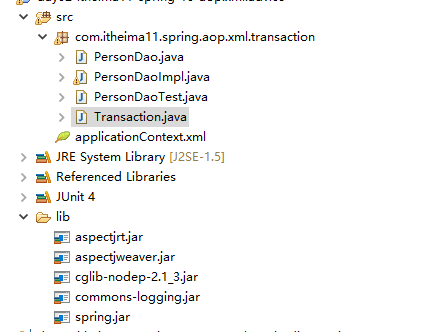在上一篇博客中我们介绍了AOP的一些基本概念,并且在博客中的Demo我们没有使用配置文件的形式来实现,在博客的结尾我们我们也抛出了那样写的问题,在这篇博客中我们就用配置文件的方式来来介绍AOP中的五大通知。
前置通知(before):在目标方法执行之前执行
后置通知(after):在目标方执行完成后执行,如果目标方法异常,则后置通知不再执行
异常通知(After-throwing):目标方法抛出异常的时候执行
最终通知(finally);不管目标方法是否有异常都会执行,相当于try。。catch。。finally中的finally
环绕通知(round):可以控制目标方法是否执行
下面就通过一个栗子来总结一下这几个通知应该如何使用.
上面截图就是demo的基本目录结构,先来说一下jar包,其中aspectjrt.jar和aspectjweaver.jar是springAOP配置文件形式所需要的jar包,其实这和springAOP的由来有联系,因为AOP的思想最原始就是aspect技术,只不过当时开发人员不知道这个技术干什么用,导致该项技术没有什么用武之地,但是到后来spring的作者意识到这种思想的优势的使用,加以整合提出aop的思想,使这项技术到达了巅峰。cglib是代理对象形成的另一种形式。
和上一篇博客对比我们可以发现,我们不需要自己写拦截器,而是在配置文件中实现。
首先来看一下配置文件:
<?xml version="1.0" encoding="UTF-8"?>
<beans xmlns="http://www.springframework.org/schema/beans"
xmlns:aop="http://www.springframework.org/schema/aop"
xmlns:xsi="http://www.w3.org/2001/XMLSchema-instance"
xsi:schemaLocation="http://www.springframework.org/schema/beans
http://www.springframework.org/schema/beans/spring-beans-2.5.xsd
http://www.springframework.org/schema/aop
http://www.springframework.org/schema/aop/spring-aop-2.5.xsd">
<!--
导入目标类
导入切面
进行aop的配置
-->
<bean id="personDao" class="com.itheima11.spring.aop.xml.transaction.PersonDaoImpl"></bean>
<bean id="transaction" class="com.itheima11.spring.aop.xml.transaction.Transaction"></bean>
<aop:config>
<!--
切入点表达式
符合切入点表达式的类要产生代理对象
expression就是切入点表达式
id 标示符
-->
<aop:pointcut
expression="execution(* com.itheima11.spring.aop.xml.transaction.PersonDaoImpl.*(..))"
id="perform"/>
<aop:aspect ref="transaction">
<!--
前置通知
1、在目标方法执行之前
2、前置通知中,方法有一个参数JoinPoint
-->
<aop:before method="beginTransaction" pointcut-ref="perform"/>
<!--
后置通知
1、在目标方法执行之后
2、能够获取目标方法的返回值
returning="val" val就是通知方法中 后置通知中的参数名称
3、如果目标方法产生异常,则后置通知不再执行
-->
<aop:after-returning method="commit" pointcut-ref="perform" returning="val"/>
<!--
异常通知
获取目标方法抛出的异常信息
throwing="ex"
-->
<aop:after-throwing method="throwingMethod" pointcut-ref="perform" throwing="ex"/>
<!--
最终通知
-->
<aop:after method="finallyMethod" pointcut-ref="perform"/>
<!--
环绕通知
能够控制目标方法的执行
环绕通知可以有返回值,这个返回值就是代理对象的方法的返回值
前置通知和后置通知只能在目标方法执行之前和之后加代码,但是不能控制目标方法的执行
-->
<aop:around method="aroundMethod" pointcut-ref="perform"/>
</aop:aspect>
</aop:config>
</beans>核心类切面代码:
package com.itheima11.spring.aop.xml.transaction;
import org.aspectj.lang.JoinPoint;
import org.aspectj.lang.ProceedingJoinPoint;
public class Transaction {
/**
* 前置通知 参数:JoinPoint 连接点:客户端调用哪个方法,这个方法就是连接点
*/
public void beginTransaction(JoinPoint joinPoint) {
System.out.println("目标类:" + joinPoint.getTarget().getClass());
System.out.println("目标方法的名称:" + joinPoint.getSignature().getName());
System.out.println("目标方法的参数:" + joinPoint.getArgs().length);
System.out.println("begin transaction");
}
/**
* 后置通知 val接收目标类的目标方法的返回值
*/
public void commit(JoinPoint joinPoint, Object val) {
System.out.println("返回值:" + val);
System.out.println("commit");
}
/**
* 异常通知 不管是否目标方法是否抛出异常,都会执行这个方法,相当于finally
*/
public void throwingMethod(JoinPoint joinPoint, Throwable ex) {
System.out.println(ex.getMessage());
}
/**
* 最终通知
*/
public void finallyMethod() {
System.out.println("finally method");
}
/**
* 环绕通知 可以控制目标方法的是否执行
*/
public Object aroundMethod(ProceedingJoinPoint joinPoint) throws Throwable {
System.out.println("around method");
return joinPoint.proceed();// 执行目标方法,如果不写行代码 则目标方法不会执行
}
}
package com.itheima11.spring.aop.xml.transaction;
import org.junit.Test;
import org.springframework.context.ApplicationContext;
import org.springframework.context.support.ClassPathXmlApplicationContext;
/**
* aop的原理
* 1、启动spring容器
* 2、spring容器会为personDao和transaction实例化
* 3、spring容器解析aop:config的配置
* 当spring容器解析到切入点表达式的时候,就会把切入点表达式解析出来
* 会让切入点表达式的类和spring容器中的类进行匹配
* 如果匹配成功,则会为该对象创建代理对象
* 代理对象的方法形成=通知+目标方法
* 如果匹配不成功,则会报错
* 4、在客户端context.getBean时,如果当前的对象有代理对象,则返回代理对象
* 如果没有代理对象返回对象的本身
* 5、在spring内部会检查目标类有没有实现接口
* 如果目标类实现了接口,则采用jdkproxy产生代理对象
* 如果目标类没有实现接口,则采用cglibproxy产生代理对象
* @author zd
*
*/
public class PersonDaoTest {
@Test
public void testSpring(){
ApplicationContext context =
new ClassPathXmlApplicationContext("applicationContext.xml");
PersonDao personDao = (PersonDao)context.getBean("personDao");
String s = personDao.savePerson();
System.out.println(s);
}
}
小编在都将重要的注释写在代码中,请读者自行体会。上面这个demo就是对于springAOP中常用的几个通知的实现,在实际的场景我们需要不同的需求来运用不同的通知来实现。
当我们对这个模式比较熟悉以后,里面比较重要是我们切入点表达式的编写,我们不在用原先的if。。else。。来实现,我们根据需求编写表达式实现。所以我们需要熟悉表达式的编写。
在下面的博客中将会利用这些基本知识,实现具体的业务需求。

